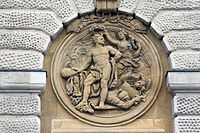Benutzer:HybridExplorer/Porte du Peyrou
Die Porte du Peyrou ist ein Triumphbogen in der südfranzösischen Stadt Montpellier. Er bildet den östlichen Zugang zur repräsentativen Grünanlage Promendade du Peyrou bzw. Place royale du Peyrou. Der Begriff Peyrou entstammt der okzitanischen Sprache und bedeutet so viel wie steinig, frz. pierreux.
Einst lag hinter dem Tor eine Zugbrücke zur Überquerung des Stadtgrabens. Heute befindet sich hier eine moderne 28m breite Straßenbrücke. Der Verlauf des ehemaligen Stadtgrabens ist heute noch durch eine Unterführung zu erkennbar.
Das Bauwerk wurde bis 1693 nach Plänen von François Dorbay errichtet, der sich an der Pariser Porte Saint-Martin orientierte. Die rustifizierte Oberfläche des Bogens unterstreicht seine kriegerische. Auf dem dorischen Gesims ruht eine breite Attika mit folgender Inschrift:
LUDOVICO MAGNO LXXII ANNOS REGNANTE DISSOCIATIS REPRESSIS CONCILIATIS GENTIBUS QUARTUOR DECENNALI BELLO CONJURATIS PAX TERRA MARIQUE PARTE 1715 (ungefähr "Ludwig dem Großen, dessen 72jährige Herrschaft 40 Jahre Unterdrückung und Feindschaft zwischen den Völkern/durch die Völker beseitigte und Frieden zu Land und zu Wasser brachte, verstarb 1715")
magno LXXII annos regnante dissociatis repressis conciliatis gentibus quatuor decennali bello conjuratis pax terra marique parta 1715"
Cet arc de triomphe porte l'inscription suivante : « Ludovico magno LXXII annos regnante dissociatis repressis conciliatis gentibus quatuor decennali bello pax terra marique pax terra marique parta 1715 », ce qui se traduit par : « Louis le Grand, dont le règne dura soixante-douze ans, a apporté la paix sur terre et sur mer après avoir séparé, contenu et s'être attaché à des peuples alliés dans une guerre de quarante années ».
À noter la présence de 4 médaillons allégoriques à la gloire du « Grand » Roi dont celui représentant la révocation de l'Édit de Nantes (qui avait assuré une certaine liberté religieuse aux protestants entre 1598 et 1685, puis a été supprimé), épisode tragique et très douloureux tant sur le plan local que national.
Bien que plus petit que la porte Saint-Martin à Paris, il mesure tout de même 15 mètres de haut et 18 mètres de large. Son portique a une ouverture de 4,70 mètreset une hauteur de 7 mètres. Il a fallu pour sa construction l'extraction de plus de 120 m3 de pierres, pour la plupart venant des garrigues, notamment les carrières, des environs de Montpellier et notamment celles de Pignan, Saint-Jean-de-Védas, Pondres ou encore Saint-Géniès des Mourgues.
The Porte du Peyrou is a triumphal arch in Montpellier, in southern France. It is situated at the eastern end of the Jardin de Peyrou, a park near the center of the city.
The arch was designed by François Dorbay, after the model of the Porte Saint-Denis in Paris. Its construction was completed in 1693. Its rusticated surface is crowned by a Doric entablature, suitable to a martial monument. Its later panels in bas-relief and inscriptions glorifying King Louis XIV of France were added in 1715.
These reliefs show four major events from the reign of Louis XIV, rendered as allegories:
the capture of Namur during the War of the Grand Alliance, in which the figure representing the Dutch Republic kneels before Louis XIV Louis in the figure of Hercules being crowned by Victory the digging of the Canal du Midi that links the Bay of Biscay with the Mediterranean Sea the Revocation of the Edict of Nantes.
- Porte du Peyrou in Montpellier (erbaut 1691)
Medaillons[Bearbeiten | Quelltext bearbeiten]
Die vier Medaillons, die sich auf beiden Seiten je rechts und links neben der Durchfahrt befinden, wurden nach Ludwigs Tod 1715 hinzugefügt. Sie stellen König Ludwigs größten "Errungenschaften" allegorisch dar.
-
Victoria krönt den als Herkules dargestellten Ludwig XIV. mit einem Lorbeerkranz. Zu seinen Füßen liegt ein besiegter Soldat.
-
Die Eroberung von Namur 1692. Die vor dem siegreichen König kniende Niederländische Republik reicht ihm die Schlüssel zur Stadt. Zu seinen Füßen liegt ein besiegter Löwe, wie man ihn auch im Wappen der Niederländischen Republik findet.
-
Der Bau des Canal du Midi. Dargestellt ist sind eine junge Frau und ein greiser Mann, die sind die Hand reichen. Sie sind Personifikationen des Mittelmeers bzw. des Atlantischen Ozeans, die der Kanal verbindet.
-
Das Edikt von Fontainebleau, das die Religionsfreiheit erneut einschränkte. Die zentrale weibliche Figur ist umgeben von flehenden und besiegten Menschen sowie einstürzenden Gebäuden und am Boden liegenden Büchern.



